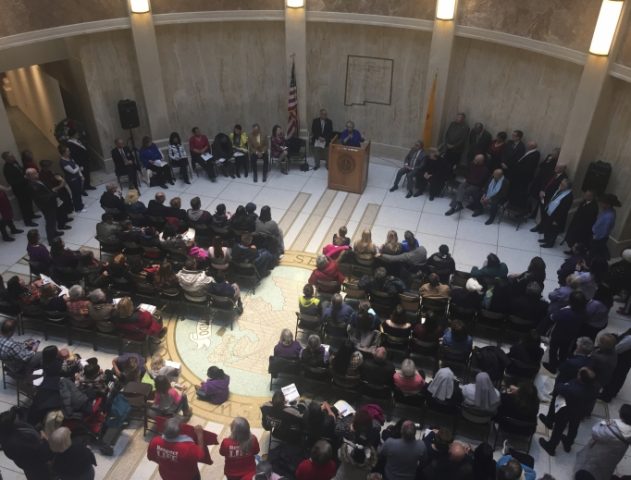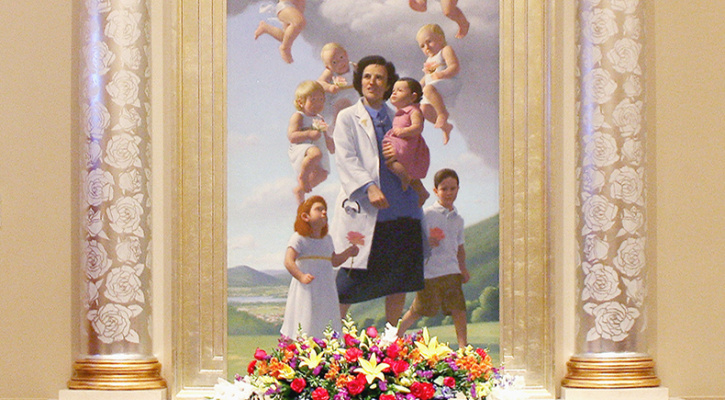Interview: Pro-Life Rhode Island Student Says She Couldn’t Stay Silent, by Patrina Mosley
March 18, 2019Why is the Feast of St. Joseph on March 19?
March 18, 2019
Supporters of bills to legalize assisted suicide claim it’s ‘a more humane way to exit the world,’ but pro-life advocates counter that it’s medically unnecessary and morally wrong.
By Stephen Beale, EWTN News, 3/18/19
While state abortion laws are seizing headlines, a quieter battle for life is playing out across the country, as at least 15 states weigh legislation that would legalize assisted suicide.
Key battleground states include Maryland, New Jersey, New York and New Mexico, where the leading advocate for the bills, Compassion and Choices, is focusing its efforts, according to Sean Crowley, a spokesman for the organization. Other states include: Arizona, Arkansas, Connecticut, Indiana, Iowa, Kansas, Massachusetts, Nevada, New York, Rhode Island, Utah and Virginia.
“A lot of states are really on the cusp of legalizing it,” said Jennifer Popik, the director of medical ethics for National Right to Life.
For a long time, Oregon was the only state that allowed assisted suicide, starting in 1997. A little more than a decade later, Washington followed suit. Then several more followed in short order through legislation or ballot initiatives: Vermont in 2013, California in 2015, Colorado in 2016 and Hawaii in 2018. The District of Columbia also legalized assisted suicide in 2016.
“It has happened fast,” Popik said. “We are concerned that it’s this sort of snowball effect. People don’t see the dangers. They don’t see the risk here.”
A number of factors are driving the trend. One is the highly publicized story of Brittany Maynard in 2014. Maynard was a 29-year-old woman who had been diagnosed with brain cancer. She moved from California to Oregon so that she could have recourse to that state’s assisted-suicide statute.
“At the time, she forcefully argued in favor of having other states follow Oregon’s lead. Her poignant story, well publicized through Compassion and Choices, brought this issue to the attention of a broad audience, including legislators,” said Lucia Silecchia, a law professor at The Catholic University of America.
Another factor is the organizational heft of Compassion and Choices, which was formed by merging End-of-Life Choices — originally the Hemlock Society — and Compassion in Dying in 2005. “This merger united their efforts, making the group significantly larger and more powerful,” Silecchia said.
Opposing Perspectives
Kim Callinan, the CEO of Compassion and Choices, told the Register she thinks there is a simpler explanation: “I think people are only one bad death away from being a supporter,” she said.
She said as many baby boomers age and watch their parents suffer at the end of their lives and consider their own mortality, they’ve realized there’s a “more humane way to exit the world.”
For Compassion and Choices, avoiding suffering is the main argument in favor of legalizing “medical aid in dying.” “Through the many incredible advances of medical technology, we have gotten to the point where we’re able to save many lives; but, unfortunately, those treatments also result in horrific suffering, and as the treatments themselves cause suffering, we like for people to have the option of ending the suffering that man has created,” Callinan said.
On the opposing side of the issue are groups like National Right to Life and the U.S. Conference of Catholic Bishops (USCCB). Greg Schleppenbach, the associate director of the USCCB’s Secretariat of Pro-Life Activities, said Callinan’s argument from suffering is not grounded in the facts.
“The Church doesn’t ask us to suffer unnecessarily. The Church absolutely teaches that we have every right to good quality pain control,” Schleppenbach said. “The reality is: In our society, we have that.”
He also noted that avoidance of pain is not the top reason that people in states with assisted suicide say they want it. According to the Patients’ Rights Council, the top four reasons for those who had requested the lethal drugs in Oregon in 2018 instead were: losing autonomy; being less able to participate in activities that make life enjoyable; losing one’s dignity; and fear of becoming a burden on family and friends. Pain or fear of pain was mentioned in 32% of cases.
“I believe that the cultural forces that may drive some to be more open to this are similar to those that underlie support for abortion: a fierce appeal to the desire for personal autonomy; a lack of meaningful support for those who find themselves in difficult situations; and a failure to recognize that the weakest among us have the same dignity and rights as the strongest,” Silecchia said.
Life as Gift
Schleppenbach said the Church has a “very balanced” position on the issue. On the one hand, it rejects assisted suicide. On the other, it does not insist that we must do everything possible to stay alive, recognizing that in some instances patients have the right to refuse treatments that will be useless, have no benefit or have burdens that outweigh any gain.
The Church’s opposition to assisted suicide is based on its teachings on the sanctity of life. “We are stewards of this life, not arbiters of our lives,” Schleppenbach said.
Professor Silecchia said the procedure goes against the core of what it means to be a doctor.
“To ‘give a deadly drug’ goes against the ancient, secular Hippocratic Oath. Thus the belief that it is wrong predates Christianity and is not dependent on a religious point of view. Thus there are compelling nonsectarian arguments against it,” she said.
Pro-life organizations, notably those in Connecticut, have also partnered with disability-rights advocates who express concerns about how such laws might affect the vulnerable.
“It will target those who are most vulnerable,” Silecchia said. “Rather than devote our energy and resources to improving the quality of medical care and the search for cures, providing lethal prescriptions can easily become viewed as a cost-effective way to manage the end of life.”
Europe’s Slippery Slope
Many opponents of assisted suicide invoke examples from Europe, where such laws appear to have led to a slippery slope in which those who are not facing terminal illnesses are taking their own lives.
For example, in 2013, two adult Belgian twins chose to be euthanized after learning that in addition to already being blind, they also would be going deaf. The twins feared being unable to communicate with each other.
Part of the debate hinges on the terminology. Rather than calling what’s in play “assisted suicide,” Compassion and Choices advocates for the phrase “medical aid in dying.”
“The term ‘medical aid in dying’ is a very descriptive term of what is happening. The person is dying. They are going to die. They have a terminal prognosis,” Callinan said. “The term ‘suicide’ refers to somebody who is not dying. … To equate suicide with somebody that has a disease that is going to kill them — that’s offensive to the dying person.”
Pro-life advocates reject such reasoning. “That is all smoke and mirrors,” Popik said.
“That’s what we call verbal engineering — and verbal engineering always precedes social engineering,” Schleppenbach said. “It doesn’t pass the laugh test. These laws — they are absolutely false. They lie about what this is. Any rational person can recognize that when you prescribe a lethal dose of barbiturates to somebody for the purpose of ending their life that that is suicide.”
Register correspondent Stephen Beale writes from Providence, Rhode Island.







